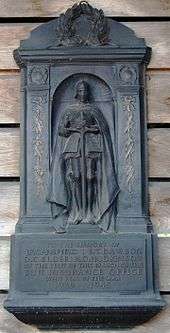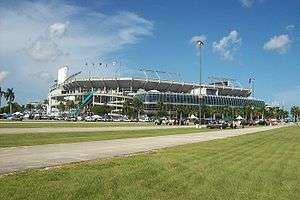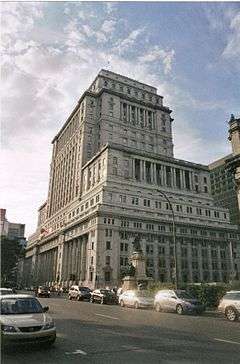Sun Life Financial
 | |
| Public | |
| Traded as | TSX: SLF, NYSE: SLF, PSE: SLF |
| Industry | Financial Services |
| Founded | 1865 in Montreal, Quebec |
| Headquarters |
Sun Life Centre Toronto, Ontario |
Key people |
James H. Sutcliffe, FIA, Chairman Dean A. Connor, President and CEO |
| Products | Financial Services, Financial planning and advice, Life insurance, Health insurance, dental insurance, disability insurance, Investments, pension plans, institutional asset management and retirement savings |
| Revenue | $19.274 billion (as of Dec 31, 2015) CAD [1] |
|
| |
Number of employees | 30,000 employees (including Joint Ventures as of Dec 31, 2015)[1] |
| Website | SunLife.com |
Sun Life Financial, Inc. is a Canada-based financial services company known primarily as a life insurance company. It is one of the largest life insurance companies in the world, and also one of the oldest with the history spanning back to 1865.
Sun Life Financial has a strong presence in investment management with over CAD$891 billion in assets under management operating in a number of countries.[2] Sun Life ranks number 277 on the Forbes Global 2000 list for 2016 as well as on the Fortune 500 list.
History
Pre-World War II
Founded in Montreal, Quebec, as The Sun Insurance Company of Montreal in 1865 by Mathew Hamilton Gault (1822-1887), an Irish immigrant who settled in Montreal in 1842, its operations actually began in 1871. By the end of the 19th century it had expanded to Central and South America, the United States, the United Kingdom, West Indies, Japan, China, India, North Africa and other international markets. During the next five decades, the company grew and prospered, surviving the difficulties of World War I and the large drain on its finances through policy claims arising from the large number of deaths caused by the Great Flu Epidemic of 1918.
The company's original Dominion Square building in Montreal was built in 1918. Capping a Montreal construction boom that began in the 1920s, the company completed construction of the expansion of its headquarters with its new 26-storey headquarters north tower in 1933. Although the head office of the Royal Bank of Canada on St. James Street was taller by several floors, the Sun Life Building was at the time the largest building in terms of square footage anywhere in the British Empire.
Chartered in 1865, its traditional base business worldwide remains life insurance, but it now also has significant asset management operations. In 1919, it was the first Canadian company to offer group life insurance. Having begun its first US operations in 1895, the company sold its first group life plan in the U.S. in 1924.
World War II

In World War II, the gold reserves and securities of several European countries were secretly moved to the Sun Life Building for safekeeping. A persistent rumour that the Crown Jewels of the United Kingdom were illegally shipped out of the United Kingdom during WWII and stored there was deliberately spread in Montreal to account for increased activity at the building.[3]
Post-World War II
During the post-war period, the company's successful business strategies made it one of Montreal's largest white-collar employers, one of the top corporations in Canada, as well as a global player in the life insurance field. For the first half of the 20th century, the city of Montreal had been the economic hub of Canada, but it was losing ground to Toronto. As early as 1950, Toronto's economic activity surpassed Montreal's with regards to stock market trading and capitalization. The advent, in the 1960s, of political and terrorist movements demanding the independence of Quebec from Canada cast a pallor of uncertainty over the business community. In 1977, the newly elected sovereigntist Quebec government passed the Charter of the French Language (known as Bill 101), making the use of French language mandatory for medium- and large-scale companies when communicating with French-speaking staff. This law was received negatively by the English-speaking business community, many of whom perceived that the historical rights of the English-speaking minority should be respected. On January 6, 1978, the company downsized the Montreal facilities to serve as a branch service bureau while shifting its head office to rented space in Toronto, Ontario. Officially, Sun Life said it was motivated by the political instability and economic uncertainty of Quebec's future, but skeptics said it was the company's unwillingness to comply with the requirements of Bill 101. In 1979, the company acquired a property at University Avenue and King Street in downtown Toronto and constructed a new office complex, the Sun Life Centre, which was completed in 1984.
Bill 101 required more than French communications with French-speaking staff. It made French the official language of the workplace. It also provided that present and prospective employees who could not speak English not be discriminated against because of their inability to speak English.
For the largest employer of English-speaking people in Montreal, this would make things very difficult. Many, if not most, of Sun Life's Head Office employees in 1979 were not fluent in French. Sun Life was quite clear that this was the reason for its move when it made the announcement. The PQ government was quick to label Sun Life "bad corporate citizens" and claimed that if "they had only warned us, we could have worked something out."[4]
The downsizing of Sun Life's Montreal office did not take place overnight. Transfers and moves occurred on a departmental basis and did not commence until several months after the announcement.
The transfer of Sun Life's Head Office from Montreal to Toronto is viewed by many to be the start of an exodus of corporate entities from Montreal, but Sun Life was not the first company to leave. Many companies had left long before Sun Life did, only on a much quieter, private basis.
There were several other key activities in the post-war years including the decision by Sun Life to leave many markets, including China and India, because of economic and political changes. In 1962, Sun Life became a mutual company and repurchased its shares for $65 million in total. In 1973, Sun Life opened its American subsidiary's new headquarters in Wellesley Hills, Massachusetts outside Boston.
1980s – 1990s
Sun Life continued to expand its wealth management business with the 1982 acquisition of Massachusetts Financial Services (MFS), the Boston-based investment management and mutual fund company. It entered the mutual fund business in Canada by forming Spectrum Mutual Fund Services in 1987 (subsequently sold to CI Financial) and a decade later, acquired McLean Budden, a Canadian investment management firm (subsequently folded into MFS). International expansion continued in the 1990s. In 1995, Sun Life entered the Indonesia market through local company PT Asuransi Modern Sun Life, now called PT Sun Life Financial Indonesia and opened a Representative Office in Beijing in preparation to enter China. A year later, Sun Life opened a services centre in Waterford, Ireland, to provide technology and business processing support for Sun Life business units.
In 1999, Sun Life officially returned to India and China when it established two joint ventures – Birla Sun Life in India with local partner Aditya Birla Group, and Sun Life Everbright in China with partner China Everbright Group. Over the next decade, both operations grew rapidly – by September 2008, there were 132,460 Birla Sun Life advisors working in 600 branches across India while Sun Life Everbright opened its sixth branch in Guangzhou, bringing its presence to 18 cities in China.
2000 to present
In early 1998, Sun Life announced its intention to demutualize. In March 2000, its Initial Public Offering (IPO) started the trading of Sun Life Financial Inc. shares on the Toronto (TSX), New York (NYSE) and Philippine (PSE) stock exchanges.
In 2002, Sun Life combined its operations with Clarica Life Insurance Company of Waterloo, Ontario. Founded in 1870 as Mutual Life of Canada, Clarica was known as The Mutual Group before it went public in 1999. The former head office for Mutual Life Assurance Company at 227 King Street South in Waterloo became the home to Sun Life's Canadian operations, while a regional office and Sun Life’s corporate headquarters remained in Toronto. The company also maintains regional offices in Montreal, Ottawa, Edmonton, Vancouver, Halifax and Calgary. After it integrated operations, the company used the Clarica brand name for certain products and activities until 2007.
In 2005, Sun Life opened a service centre in Gurgaon, India to provide business processing and technology support for Sun Life Financial business units around the world. That same year, Sun Life purchased CMG Asia and CommServe Financial, the Hong Kong insurance and pension operations of the Commonwealth Bank of Australia, tripling its customer base and adding group insurance and pensions to its business lines.
In 2007, Sun Life purchased the U.S. employee benefits business of Genworth Financial, placing itself in the top 10 in the U.S. group benefits market.
In 2008, Sun Life sold its 37% interest in CI Financial Income Fund to Scotiabank. Sun Life had originally acquired a significant ownership interest in the firm by selling its Canadian mutual fund subsidiaries to CI Financial in 2002.[5]
At September 30, 2008, Sun Life had assets under management of C$389 billion and including joint ventures had more than 28,000 employees and 147,590 advisors in 22 countries serving more than 25 million customers worldwide. Birla Sun Life Insurance is ranked as one of the top six privately owned life insurers in India.[6] While in Canada, Sun Life is ranked #1 in several lines of business including Defined Contribution Pension Plans, Group RRSPs and Deferred Profit Sharing Plans.[7]
Sun Life Financial Inc. shares trade on the Toronto, New York, and Philippines stock exchanges. It is one of Standard & Poor's Global 1200 companies.
In 2009, Sun Life began an aggressive nationwide ad campaign in the United States touting its strength and the fact that it did not accept any bailout money. The commercials parody the concept of naming rights, where a couple of naïve employees go around the country attempting to put the company's name on various sun-themed things, from KC and the Sunshine Band to Cirque du Soleil to the state of Florida. In a case of life imitating art, on January 18, 2010 Sun Life purchased the naming rights for the home field of the Miami Dolphins in Miami Gardens, Florida for a reported US$7.5 million per year.[8] Under the five-year contract the stadium is named Sun Life Stadium.
In 2013, Sun Life acquired 49% Aviva PLC’s Malaysian insurance joint venture with lender CIMB Group. Sun Life acquired the business along with Malaysian state investor Khazanah Nasional, which also purchased 49%. They each paid approximately CDN$300 million. CIMB retains 2% interest.[9]
Asset Management
Beside having a strong presence in asset management industry through MFS Investment Management and Sun Life Global Investments (Canada) Inc. that it launched in 2010, Sun Life financial also started a third-party asset-management arm in 2014, under the brand name Sun Life Investment Management, seeking to add fee revenue and distance itself from more capital-intensive operations such as annuities. The insurer in May 2014 hired Carl Bang from the Qatar Foundation Endowment as president of Sun Life Investment Management Inc. to help lead a push with pension clients.
Sun Life had about $734 billion of assets under management as of Dec. 31 2014 including mutual funds and insurance-unit holdings.
In January 2015, Sun Life Financial Inc. announced its purchase of U.S. asset manager Ryan Labs, adding US$5.1B under management to strengthen its asset management presence in United States. It is part of the Sun Life Investment Management organization.
In July 2015, Sun Life Financial Inc. completed its purchase of U.S. asset manager Prime Advisors, Inc., adding US$13B under management. It is part of the Sun Life Investment Management organization.
The company operates in India as Birla Sun Life Asset Management. Established in 1994, Birla Sun Life Asset Management Company Ltd. (BSLAMC), investment manager for Birla Sun Life mutual fund, has been a joint venture between the Aditya Birla Group and Sun Life Financial Inc. since 1999. Birla Sun Life Mutual Fund is the fourth largest Fund house in India based on domestic average assets under management as published by AMFI for the quarter ended March 31, 2014.
Sun Life Financial also has strong asset management presence in Philippines. It is currently the largest non-bank affiliated asset management company in the country with almost P47 billion in assets under management (AUM) as of December 2014.
Headquarters
The Sun Life Centre in Toronto, Ontario was built in 1984 to house the worldwide corporate headquarters of Sun Life (now Sun Life Financial), which are based in the East Tower. Sun Life no longer owns the West Tower.
Located at the corner of King Street West and University Avenue, the taller East Tower is in the Financial District while the slightly shorter West Tower is located in the area known as the Entertainment District.
The top floor of East tower, as well as space on 16th and 25th floor is occupied by the St. Andrew's Club and Conference Centre and provides excellent views of the city. The Sun Life Centre is connected to Toronto's PATH system and the two towers share an underground connection to St. Andrew Subway Station.
Toronto's Sun Life Centre complex should not be mistaken for the Sun Life Building in Montreal, the former head office.
In 2010, the Sun Life Centre was awarded LEED Gold certification under the Canada Green Building Council's LEED for Existing Buildings: Operations & Maintenance green building rating system.[10]
Before Sun Life Centre, Sun Life Building in Montreal was the former head office. The Sun Life Building is an historic 122 m (400 ft), 24 storey office building at 1155 Metcalfe Street on Dorchester Square in downtown Montreal, Canada.
Sun Life Stadium

The American football stadium previously known as Sun Life Stadium is in Miami Gardens, Florida, a suburb of Miami. It is the home stadium of the Miami Dolphins National Football League team, and the University of Miami Hurricanes football team. It also hosts the Orange Bowl, an annual college football bowl game. It was the home to the Florida Marlins baseball team from 1993 to 2011. Originally named Joe Robbie Stadium, it has also been known as Pro Player Park, Pro Player Stadium, Dolphins Stadium, Dolphin Stadium, and Land Shark Stadium. The stadium's naming rights deal with Sun Life Financial expired in January 2016. Related Companies founder and chairman Stephen Ross, owner of the Miami Dolphins, announced a new name for the Miami Dolphins stadium in August 2016: Hard Rock Stadium. Hard Rock International will brand the newly renovated stadium. The Dolphins invested $500 million into the stadium’s renovations, including a canopy with a Hard Rock logo that covers most of the 65,326 seats.[11]
Corporate governance
Current members of the board of directors of Sun Life Financial are:[12]
|
|
Notes
- 1 2 3 "2013 Annual Report" (PDF).
- ↑ 2013 At A Glance (PDF). Sun Life Financial.
- ↑ Alfred Draper (1979). Operation Fish: The Race to Save Europe's Wealth, 1939–1945. Cassell. pp. 255–257. ISBN 978-0-304-30068-6.
- ↑ Reporters: Karen Birchard, Richard Inwood (January 6, 1978). "CBC reports on Sun Life leaving Montreal in 1978". The World At Six. Retrieved 2014-08-18.
- ↑ "CBC News - CI Fund acquires Sun Life mutual fund business". 22 May 2002. Retrieved 2008-12-28.
- ↑ "Life Insurers Market Share". dalalstreet.biz. March 14, 2008. Retrieved 2014-08-18.
- ↑ 2008 Capital Accumulation Plan Report, Benefits Canada, as of June 30, 2008
- ↑ Lefton, Terry (January 18, 2010). "Dolphins sell stadium naming rights to Sun Life". South Florida Business Journal. Retrieved 2014-08-18.
- ↑ Cameron French and Yantoultra Ngui (January 17, 2013). "Sun Life, partner to buy Aviva's Malaysian insurance JV". Reuters.
- ↑ http://www.cagbc.org/AM/PDF/LEED_Certified_Projects_in_Canada_Updated_110325.pdf
- ↑ http://www.miamiherald.com/sports/nfl/miami-dolphins/article96001322.html
- ↑ "Sun Life Financial Inc (SLF:US)". Bloomberg Businessweek. Retrieved 2014-08-18.


